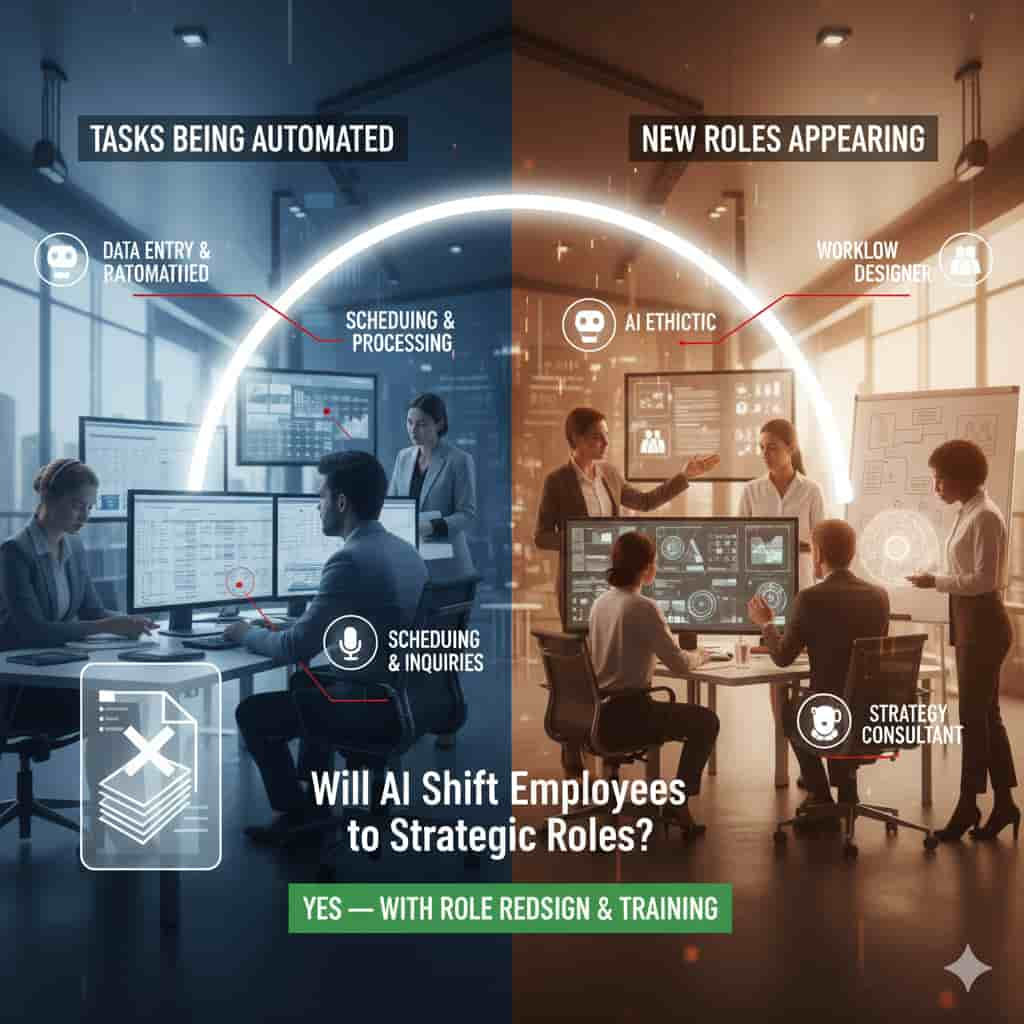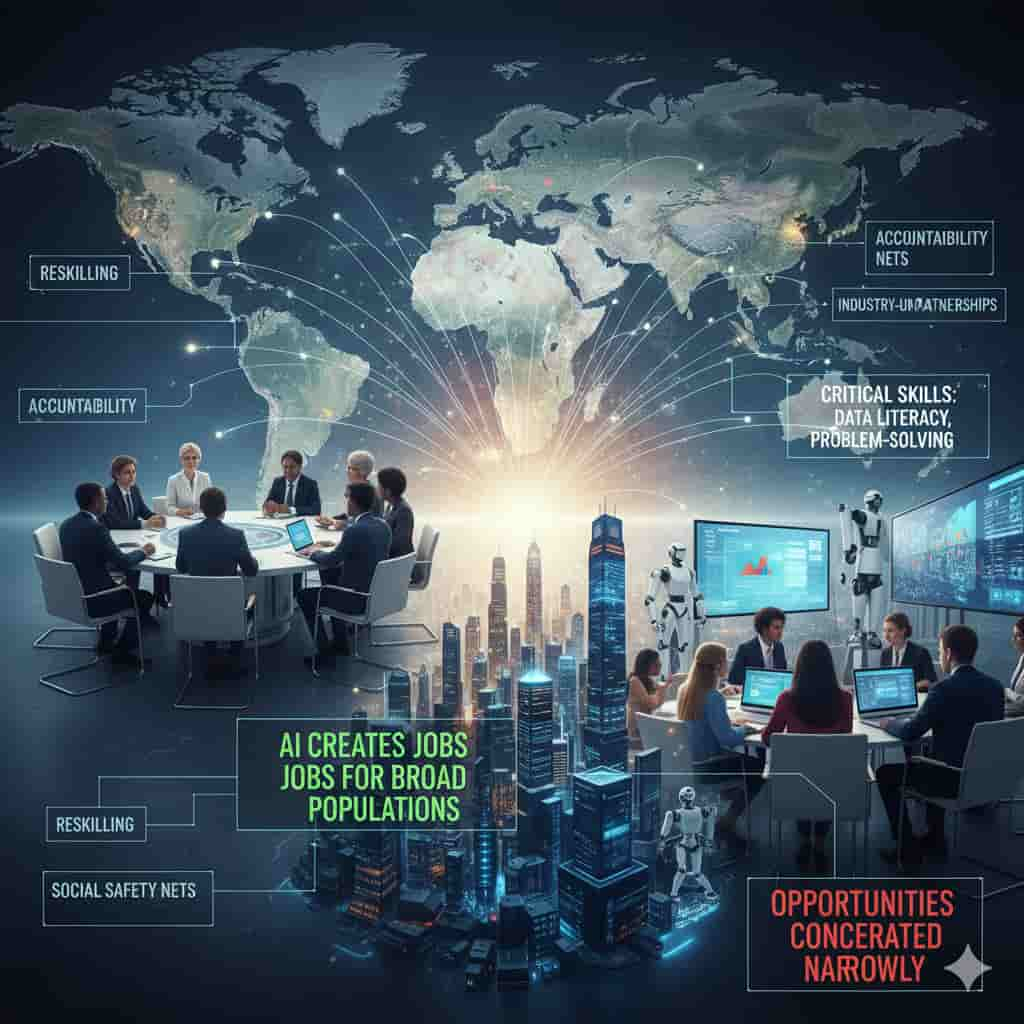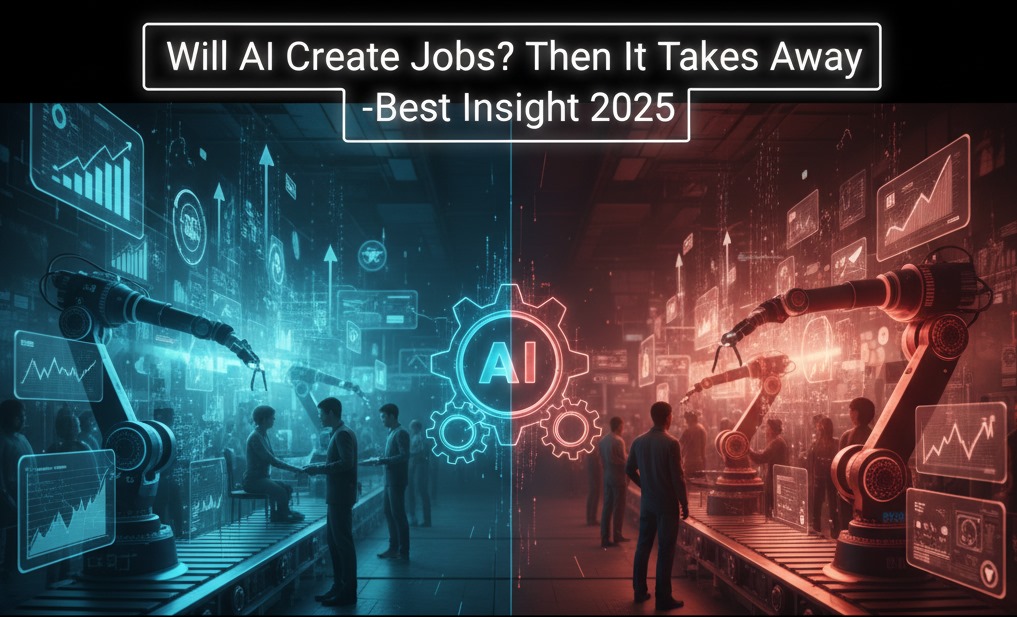1. Introduction
Artificial intelligence (AI) is already transforming the workplace; it is no longer merely a sci-fi concept. The real question facing business executives is straightforward and pressing: Will AI increase employment or decrease it? This is significant because AI-related decisions currently influence hiring, budgeting, and long-term strategy.
2. What Is the AI and Jobs Debate?
One question dominates the discussion: Will AI eventually replace more jobs than it creates, or will AI Create Jobs? Humans employ two diametrically opposed frames: augmentation and automation. While augmentation enables people to perform their jobs more effectively and quickly, automation eliminates tasks or roles by using machines.
When software performs repetitive tasks that were previously performed by humans, automation is evident. When AI does the heavy lifting, humans can concentrate on making decisions, forming connections, and being creative. This is known as augmentation. Within a company, both outcomes can happen simultaneously.
Why are leaders in business and finance interested in this debate? because decisions regarding AI have an impact on capital allocation, expenses, and talent strategy. Leaders need to ask: Will AI reduce roles in ways that harm reputation and long-term capability, or will it create jobs that boost margins while maintaining morale? Whether a business chooses to invest in rapid replacement or reskilling is determined by this distinction.
In the end, the argument is not just technical. The question of who benefits from increased productivity and how transitions are handled is both strategic and moral.
For years to come, the answers will determine worker outcomes, competitive advantage, and policy.
3. Historical Context: Technology and Job Shifts
We gain perspective from history. Prior industrial revolutions created entirely new industries and jobs while also replacing some forms of physical labor. The advent of computers led to the automation of administrative duties and the emergence of new occupations such as software development and information technology. In e-commerce, marketing, and cloud services, the internet created many new jobs while eliminating others.
There were three lessons from those previous shifts. First, rather than completely replacing work, technology alters the composition of jobs. Second, new positions frequently call for different skill sets. Third, the shift may be difficult and uneven for different industries and geographical areas.
AI is different because it targets the intelligence layer of work — analysis, language, and decision-making. That means both manual and white-collar tasks are in scope.
For example, AI can handle document review, data analysis, and routine customer interactions.
This leads to the big question every firm must ask: Will AI create jobs that are higher value, or will it mainly cut roles where workers have few alternative options? The answer will depend on adoption speed, investment in people, and policy responses.
4. How AI Create Jobs Today
AI is already altering the nature of work in a number of industries. AI speeds up modeling, automates compliance reporting, and manages fraud detection in the financial industry. AI simplifies administrative tasks, AI Create Jobs, suggests treatment options, and aids in imaging interpretation in the healthcare industry. Predictive systems are used in logistics to optimize inventory and routes. AI powers chatbots and personalizes offers in retail.
Routine, rule-based tasks like data entry, simple transaction processing, scheduling, and standard queries are the most vulnerable. They frequently move first and are the simplest to automate.
Meanwhile, new roles are emerging. Businesses require workflow designers to integrate AI and human processes, data specialists to oversee quality, and AI ethicists to establish boundaries. The need for consultants who can convert AI results into strategy is also rising and AI Create Jobs.
Will AI create jobs that move workers from routine tasks to strategic roles? This is a useful question for leaders. The answer is yes for many businesses, but only if executives make a conscious effort to rethink roles and provide training.

5. Benefits of AI for the Workforce
AI has definite advantages when applied carefully. First, by taking over laborious tasks, it boosts productivity and AI Create Jobs. Employees can then concentrate on innovation, client relations, and problem solving. Second, AI makes it possible for new business models to emerge, like automated advisory services or subscription services with tailored recommendations, which generate new job opportunities.
Third, AI can improve the caliber of work. Jobs can become more interesting and concentrate on creativity and judgment by eliminating monotonous tasks. For example, accountants who use AI for reconciliation can devote more time to strategy advice for their clients.
Benefits don’t just happen, of course. Planning how to use AI to enhance skills and develop career pathways is essential for businesses looking to gain an advantage. The main practical question that leaders need to consider is whether AI will result in meaningful and long-lasting jobs or if it will only reduce the number of workers for temporary benefit. Businesses that respond in the affirmative make investments in their personnel and procedures.
6. Risks and Challenges of AI in Employment
Adoption of AI Create Jobs has risks as well. The most evident is displacement: occupations that depend on repetitive duties may become obsolete. This results in long-term structural changes in local economies as well as immediate income difficulties for workers.
The skills gap is a second risk. The training necessary to transition into higher-value positions is lacking for many displaced workers. There are reskilling programs, but they are costly and difficult to scale effectively. Labor markets become more divided and inequality increases if reskilling is delayed.
The uneven geographic impact is a third problem. While some developing regions may lose a significant number of routine jobs, advanced economies with robust training institutions may be able to acquire new AI jobs. Global inequality may be exacerbated by that geographic division.
Finally, there’s reputational risk. If companies focus only on short-term savings and ignore employee well-being, they can face backlash, regulatory scrutiny, and talent shortages when markets shift again. Leaders must weigh: Will AI create jobs in ways that are fair and transparent, or will it concentrate benefits among a few?
7. Will AI Create Jobs Than It Destroys?
This is the central query for policy and business. Both sides have valid points of contention.
On the plus side, history indicates that technology will eventually create more roles. AI has the potential to create new industries, AI Create Jobs, including training providers, specialized consultancies, and AI service companies. Collaboration between humans and AI Create Jobs may also result in hybrid roles that combine speed, scale, and judgment.
On the cautious side, AI is unparalleled in its speed and scope. AI extends into cognitive work, in contrast to previous waves that primarily addressed physical or administrative tasks. There are fewer natural buffers for displaced workers due to the rapid pace, and many workers may be left behind if AI Create Jobs are concentrated in a small number of cities or companies.
Examine the information. According to some international surveys, net job creation will occur as new positions replace lost ones. Others caution that many workers will require new skills or new industries to employ them. The conflicting evidence suggests that whether the outcome is favorable will depend on corporate response and policy.
A useful lesson for leaders is this: Will AI Create Jobs generate employment in your company or industry? How you use AI will determine the truthful response. Jobs are lost when automation occurs without retraining. Automating and retraining can lead to the emergence of new roles. The strategic decision is obvious.
Read more: The Highest Paying Jobs In The Age of AI According To AI
8. How Businesses Can Prepare for AI-Driven Change
Businesses have agency. Leaders should concentrate on three priorities in order to slant results in the direction of value and job creation.
Invest in upskilling and reskilling first. Provide hands-on, role-based instruction in domain applications, AI interaction, and data literacy. Partnerships with training providers or internal “AI academies” may work well.
Second, rethink roles to emphasize teamwork. Analyze processes to find areas where AI Create Jobs can eliminate monotony while preserving human oversight, compassion, and sophisticated decision-making. Will AI create jobs that free up workers to do higher-value work? That redesign transforms a threat into an opportunity.
Third, employ workforce planning that is agile. Execute pilot projects and scenarios, assess results, and make adjustments. You can pivot away from damaging models and scale successful ones with flexible plans.
The possibility that AI Create Jobs materializes when companies integrate those steps. More than curiosity or fear alone, proactive plans influence results.
Read more: Closing Education Gap Best in 2025
8. The Role of Policy and Education
Systems of government and education are important. By providing funds for reskilling, encouraging the responsible use of AI, and modernizing social safety nets, policy can facilitate transitions. Regulations that promote accountability and transparency lessen harm.
Curricula for critical skills like data literacy and problem-solving should be updated by educational institutions. Universities and industry can collaborate to co-design courses that address real-world business requirements.
Approaches will vary by region; some will place more emphasis on protection, while others will focus on quick adoption. These decisions affect whether AI will concentrate opportunities narrowly or create jobs for large populations across countries.

9. Future Outlook: Scenarios for Jobs in the AI Era
We can envision a number of situations.
Positive: AI Create Jobs opens up new industries and professions. Employees transition from standard tasks to AI system design, maintenance, strategy, and oversight. Will AI lead to job creation in this world? Yes, and those are more valuable jobs.
Pessimistic: Reskilling lags and displacement occurs quickly. Long-term unemployment and social strain are problems in some areas. Will AI then lead to job creation or AI Create Jobs? Not widely, just in pockets.
Balanced: While some industries grow, others contract. To manage transitions, companies, governments, and training providers work together. Here, timing and coordination will determine whether AI creates jobs.
Read more: Life After AI Takes Our Jobs: The Rocky Road to 2035 …
10. Frequently Asked Questions
Will AI replace white-collar jobs or mostly blue-collar jobs?
AI affects both. Routine blue-collar tasks are vulnerable, but knowledge work like document review, basic analysis, and standard reporting is also at risk. That means both sides of the labor market must adapt.
Which industries are most at risk from AI disruption?
Customer service, logistics, retail, and parts of finance and insurance face rapid change. Healthcare and education are adapting but also gaining new AI-enabled roles.
What new jobs is AI expected to create?
Expect roles in AI governance, data curation, human-AI workflow design, AI product management, and fields that translate technical outputs into business outcomes.
How long will it take for AI to significantly change the job market?
Major shifts may unfold over 5–10 years in many sectors, though the timeline varies by industry and region.
Can reskilling realistically offset job losses?
Yes, but only if reskilling is large-scale, practical, and tied to real job pathways. Short workshops alone won’t close the gap.
What role should governments play in AI workforce transition?
Governments should fund training, support displaced workers, encourage responsible AI deployment, and update policies to match the pace of change.
Will AI affect developing and developed countries differently?
Yes. Developed countries with strong training and capital may capture growth. Developing regions may face higher disruption without targeted support.
How can businesses balance cost savings with employee well-being?
Reinvest a portion of savings into training, clear communication, and role redesign. That approach preserves trust and prepares the firm for long-term success.


1 thought on “Will AI Create Jobs? Then It Takes Away Best Insight 2025”